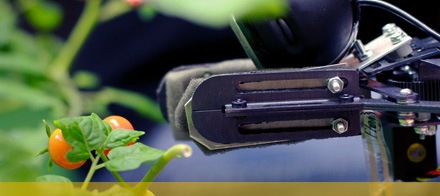Fuji Heavy Industries autonomous farming robot
14.5 years ago garden maintenance, robot
We have seen MIT students making robots to tend on their plants. Now Fuji Heavy Industries has created a robot that can completely take care of your fruits and vegetables in your fields (or greenhouse) for a modest fee of only $100,000. You can pick up your own by the next fiscal year.
It uses lasers with reflective panels to orient itself and is 6.5 feet long, unfortunately there are not too many additional geeky details which probably would be helpful before putting down the $100K for this bad boy.
Given this is the cheap vegetable gardener, I will be sticking with my hands and trowel next fiscal year though can’t wait to see a video if this in action.
Tags: cheap, outdoor plants, vegetables
Tending your garden with am army of robots
15.1 years ago computer, electronics, garden maintenance
I must say gardening and robotics are a couple of non relating interests, well at least until now. Fortunately some smart students at MIT have joined these two areas into one. I am a little skeptical about the real world implementation of this, I guess if production cost was low enough and you had a large enough green house; a little army of plant tending robots would be a cool site to see.
Either way, this a really cool academic project. See the video below for the robots watering and harvesting some tomatoes.
“The idea for the project came from work done by Nikolaus Correll, a postdoctoral assistant working in Professor Daniela Rus’ Distributed Robotics Lab. Correll, who came to CSAIL in 2007, saw the possible applications of swarm robotics to an agricultural environment. In the long view, the researchers hope to develop a fully autonomous greenhouse, complete with robots, pots and plants connected via computation, sensing and communication. Each robot is outfitted with a robotic arm and a watering pump, while the plants themselves are equipped with local soil sensing, networking, and computation. This affords them the ability to communicate: plants can request water or nutrients and keep track of their conditions, including fruit produced; robots are able to minister to their charges, locate and pick a specific tomato, and even pollinate the plants.”
[via MIT via Make via Gizmodo]
Tags: outdoor plants, tomato plants
Getting the garden ready for winter
15.5 years ago garden maintenance
The leaves are changing and falling the days are getting colder and I am personally coming to the end of my vegetable growing season. I do have a few post season activities before I completely call it a year.
Remove plants: Now my plants have lived a good life but now need to be removed. I mulch my lawn so I am always lacking greens for my compost bin so this is a good time to get some new materials. Most of my remaining plants are tomato, pumpkin, and cucumber plants which have some tough skins so I will chop them up with my lawnmower prior to add them to my modest bin. While you have your mower running this is a good time to let it keep running until it runs out of gas to avoid gumming up the engine when you fire it up next spring. This is also a good time to inspect and sharpen or replace the blade since if you are like me you will completely forget about this when you finally get around to mowing next spring.
Fertilize: If you only can fertilize one time throughout the year now is the time because turf grasses have the ability to store food during the winter months to allow a very quick rebound after the winter months. My primary concern is for my lawn which I am applying alfalfa pellets, since we have had some intense rains these past weeks they should break down quickly and not have the appearance of goose poo for too long. While applying I also allowed some to fall into by beds to help microbial activity and give my empty beds a head start for next spring. Be sure to avoid beds with and vegetation since you want to avoid any new growth with first hard freeze coming up.
Turning the soil: This can be a controversial activity since messing with the soil can inhibit microbial activity though turning the soil now can give you a head start next spring. My motivation is more on the lines if killing baby slugs (I know I am cruel) The slug activity in my garden was pretty minimal but I have concerns the few visitors may have decided to raise a family in my bed for next year. If I simply turn the first few inches of the soil I can expose the tiny slug eggs which birds will eat as a snack and any remaining will be destroyed during our first good frost. As an added benefit this will be a good time to catch up on my slacking in weeding during the last few weeks.
Taking care of your tools: Now is a good time to find those missing tools that may be hiding in your yard and garden. I have no idea why manufacturers choose to make these things green; almost like they want us to lose them to buy more ïŠ If you find any of your tools it is a good idea to put a light coating of oil on metal parts of your tools. You can also apply some Linseed oil to the wood portion of your tools.
Frosting on the top: At this point my garden is looking pretty good….even tempted to start planting though I will resist the urge. I have a plan to hold me over this winter but that will require its own post. After I have had a couple good frosts to kill off any slug eggs I will break open a couple of my bags of leaves and spread on a solid layer on top of my beds. Not only will this provide some food and temperature protection for the worms in my garden but whatever remains will be a great addition of organic matter for my garden.
Now with all this work I should be ready to start gardening way earlier than I should next spring…will I ever learn.
Tags: birds, cheap, compost, garden seeds, organic vegetables, outdoor plants, tomato plants, vegetables, worms





